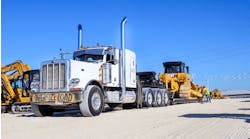During 2015, notes Rich Carroll, vice president of sales & marketing at Jost International, 30% of the company’s OEM fifth wheel shipments were air release products. “We expect that to increase moving forward,” he says. “While the simple operating principle of fifth wheels hasn’t changed, we are now experiencing an evolutionary progression toward automation of the coupling process using cab-actuated air release mechanisms.”
Cab-actuated fifth wheel release and locking systems are being adopted for both ease of operation and as a tool that can help minimize injuries and insurance claims. SAF-Holland offers an air release fifth wheel lock option that the company says makes it easier and safer for drivers to uncouple from trailers.
The Fontaine fifth wheel electronic lock indicator solution, an option on the company’s 7000 and 7000CC Series top plates, uses wedge and kingpin sensors and a control module to communicate kingpin lock status on an in-cab visual indicator.
The Jost JSK37USA cab-actuated air release system, which operates primary, secondary and third locks, functions independently from the release arm and is protected by an interlock. The system requires that the vehicle be stopped and trailer brakes set before air is provided to the cab controls.
Another solution, introduced in 2014, is the Fontaine dual assist camera system featuring two video cameras that give drivers a view of both the fifth wheel and the trailer. Mounted back-to-back behind the fifth wheel and wired to a display in the cab, the cameras are turned on automatically when the vehicle is shifted into reverse.
“As the tractor begins to back up to couple with a trailer, the in-cab monitor displays video from the rear-facing camera, and crosshairs are superimposed over the screen to help the driver properly center the vehicle,” explains Gregg Stohler, vice president of sales and marketing. “As the camera setup passes under the kingpin, the video feed in the cab automatically switches to the camera facing the fifth wheel, allowing the driver to watch the kingpin enter the fifth wheel.”
While automation of the fifth wheel coupling process is taking place, manufacturers also continue to enhance their products in different ways. At SAF-Holland, relates Jason Howe, director of fifth wheel engineering, the company’s FW16 model is a low-lube version of the FW17, which does not require greasing of the top plate. “Low-lube assemblies minimize maintenance requirements and allow for more consistent articulation in all applications and weather conditions,” he states. “The fifth wheel also comes standard with a tube for easy lubrication of the kingpin lock, which can be done when attached to a trailer.”
Weight is also still a focus of fifth wheel design, notes Doug Dorn, vice president of fleet/end user development at SAF-Holland. “Cast steel fifth wheels allow for the optimal balance between weight and strength,” he says. “Fleets get the best overall durability at the lightest weight possible with cast steel fifth wheels compared to ductile iron and fabricated steel models.”
Fontaine’s 6NWB air slide assemblies, which are direct replacements for NTLWO models with 6000 Series top plates, are also light in weight, notes Stohler.
Along with ongoing development for weight reduction to boost payload capacity and reduce maintenance of fifth wheels to lower costs, manufacturers continue to work on new solutions aimed at enhancing safety.
“These developments include sensor systems that provide positive indication of locked fifth wheel conditions,” Carroll says. “Overall, the automatic connection of systems that currently require driver involvement, such as fifth wheels, coincides with a move to minimize the driver’s responsibility because of demographics and to reduce the likelihood of injuries.”


